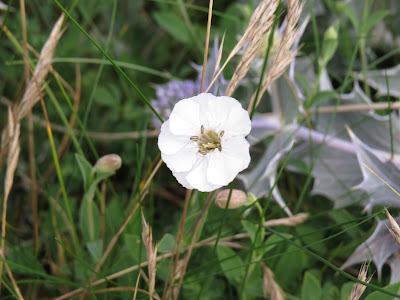On Friday (28th) I headed to my usual seawatching spot at the Obs as there was a morning tide about mid-morning. As the tide ran in and started to cover the shore it pushed a few waders past me including 403 Oystercatchers, 96 Dunlins, 208 Knots, five Curlews, 66 Turnstones, 39 Ringed Plovers, a Redshank and two Sanderlings.
On the sea it was relatively quiet with 60 Common Scoters, 43 Cormorants, 35 Sandwich Terns, 49 Gannets, a Fulmar and an Auks sp.
The highlight of the morning was a juv. male Peregrine that gave a fantastic display offshore above the waves chasing small waders. It made several stoops, but unfortunately for the 'Peg' each attack was unsuccessful. In the end it gave up and headed back to the shore.
Saturday (29th) evening found Graham, Ian and Me at the Swallow roost. Due to the unsettled weather of late there weren't quite as many coming in, perhaps 800, and consequently we only ringed 40 Swallows and one Reed Warbler.
From a birding perspective the supporting cast included 60 Lapwings, 40 Linnets, a male Peregrine, a Kestrel, three House Martins, 3,000 Starlings and a Buzzard.
After just two hours sleep (I won't bore you with the details) I was up at 5:00 am Sunday (30th) morning to go ringing at the pools with Ian. Putting the nets up it 'felt' quiet and it was indeed quiet! In fact it has been quiet all summer at this site, and others, due to a particularly poor breeding season. The only warbler species that seems to have done okay is Reed Warbler.
We ringed just eight birds as follows (recaptures in brackets):
Lesser Whitethroat - 1
Reed Bunting - 3 (1)
Linnet - 1
Reed Warbler - 1
Wren - 2 (1)
Linnet
Reed Bunting
There was some exodus of birds from local roosts not long after first light including 17 Magpies and 28 Alba Wagtails. On the pools were a Wigeon, two Shovelers, 11 Coots, eight Little Grebes and two Cetti's Warblers called close by.
This morning I went out looking for migrants with Gail after the heavy showers last night. In fact at 4:00 am Gail and I were in the garden emptying a soggy moth trap with lots of moths in it and all were released successfully!
Migrants were a bit thin on the ground other than a male Wheatear on the estuary but a number of butterflies were on the wing including Common Blues, Speckled Woods, Peacocks, Painted Lady's, Small Tortoiseshells, Green-veined Whites and Small Whites.
Female Common Blue
Speckled Wood
It's more Swallows this evening so fingers crossed for a decent catch!






























